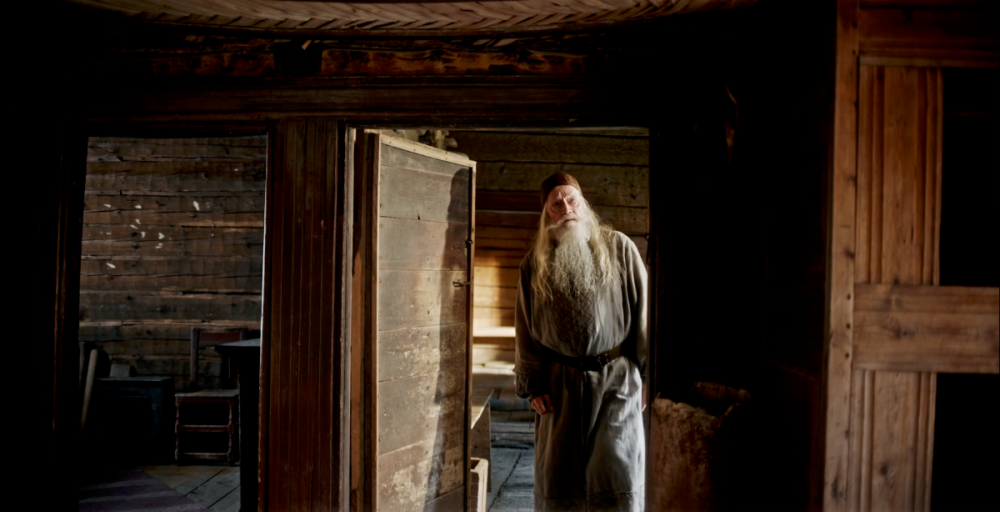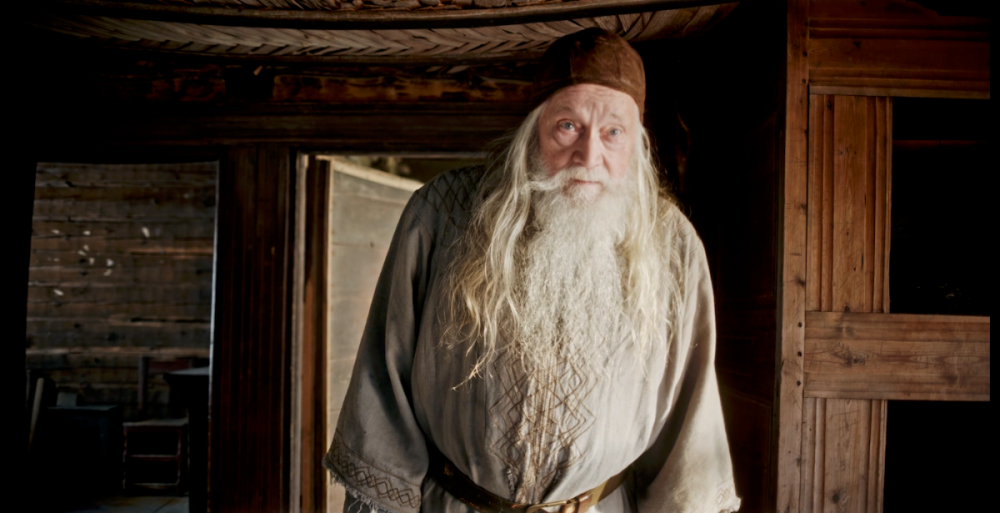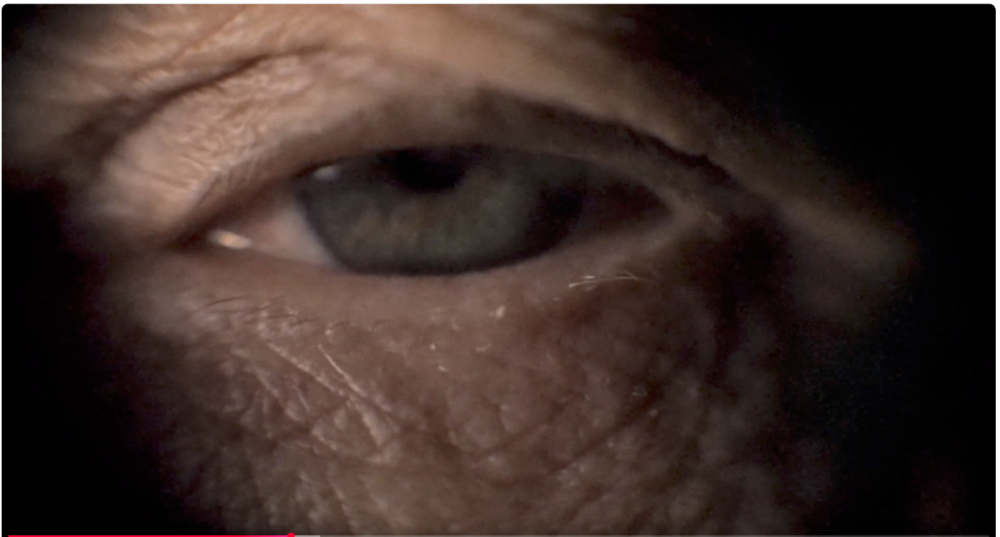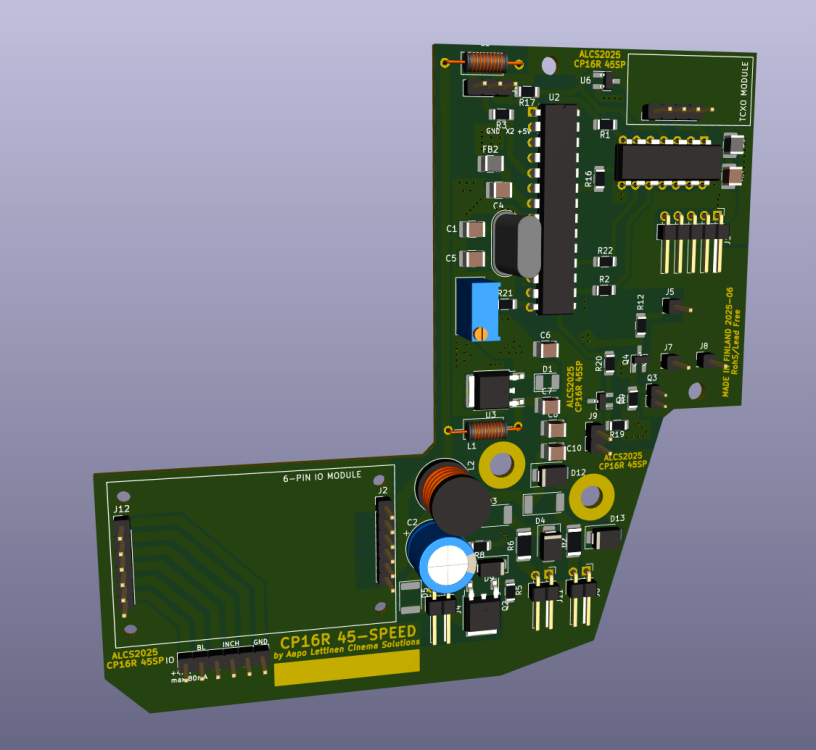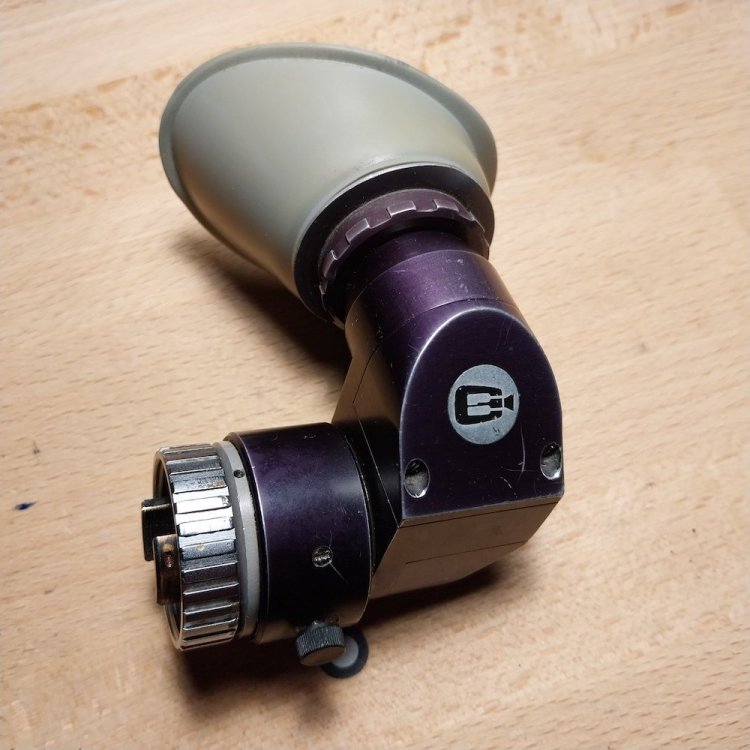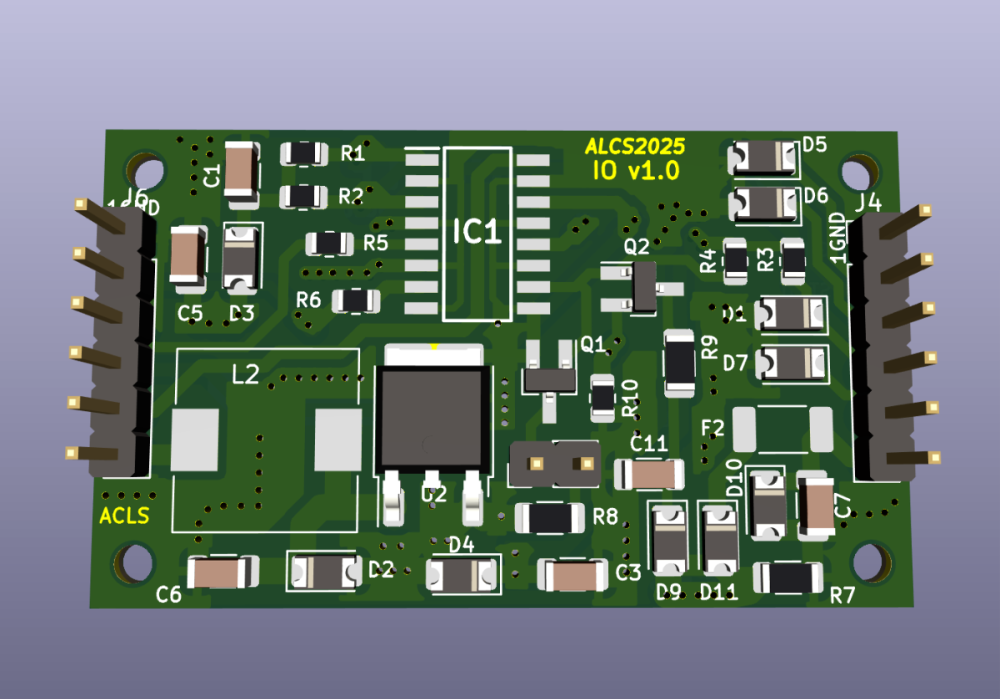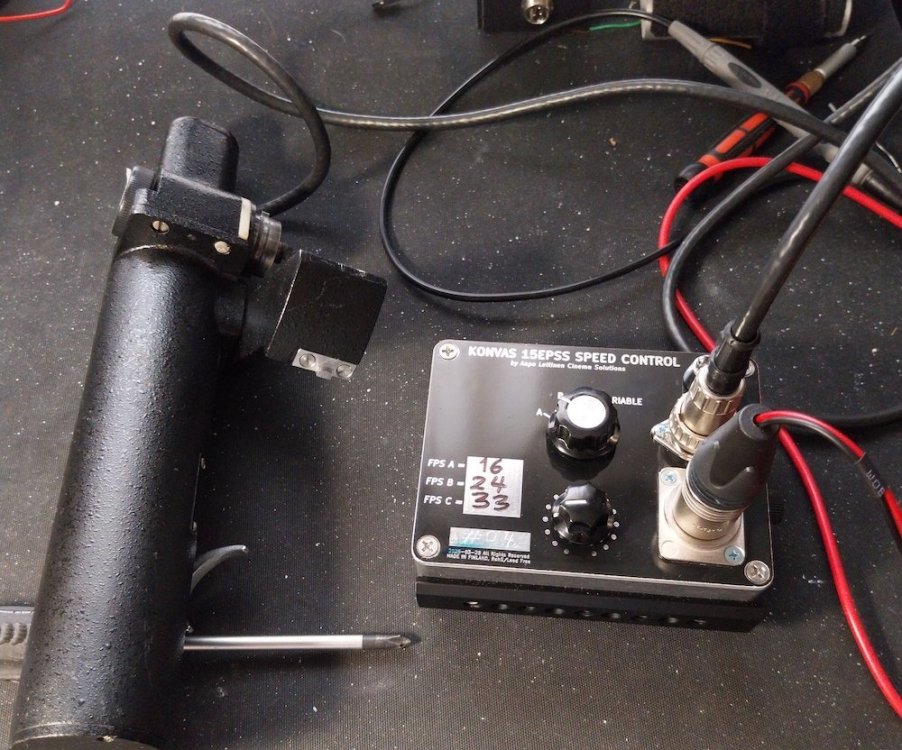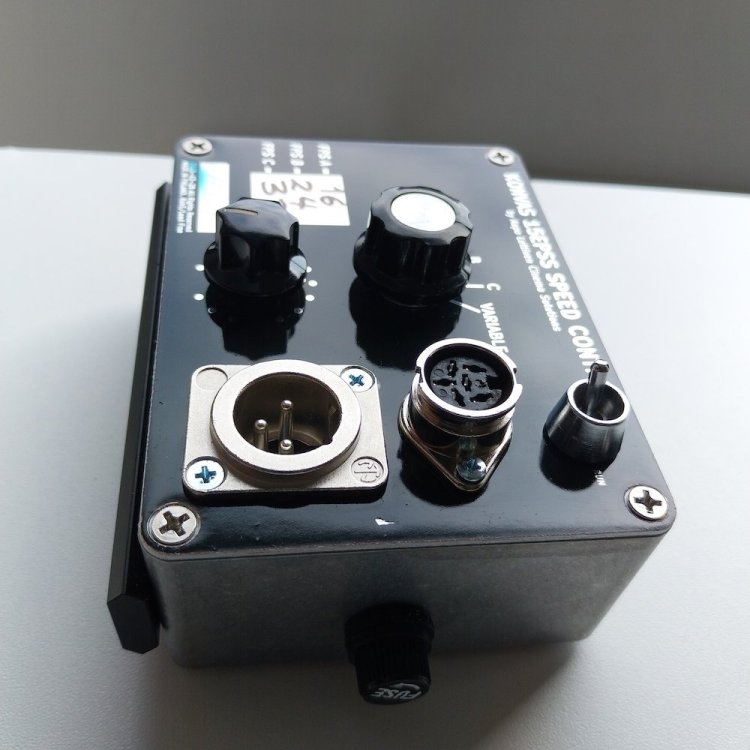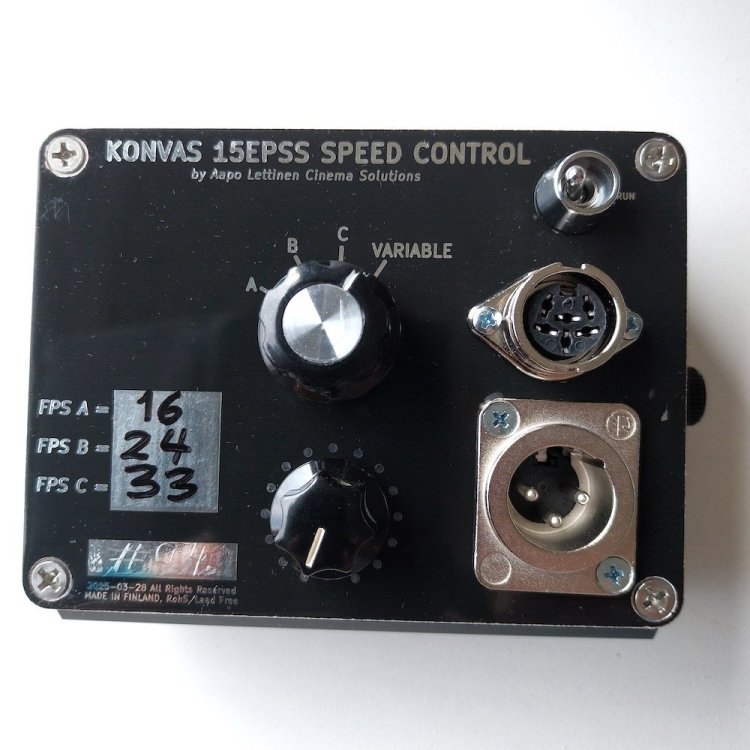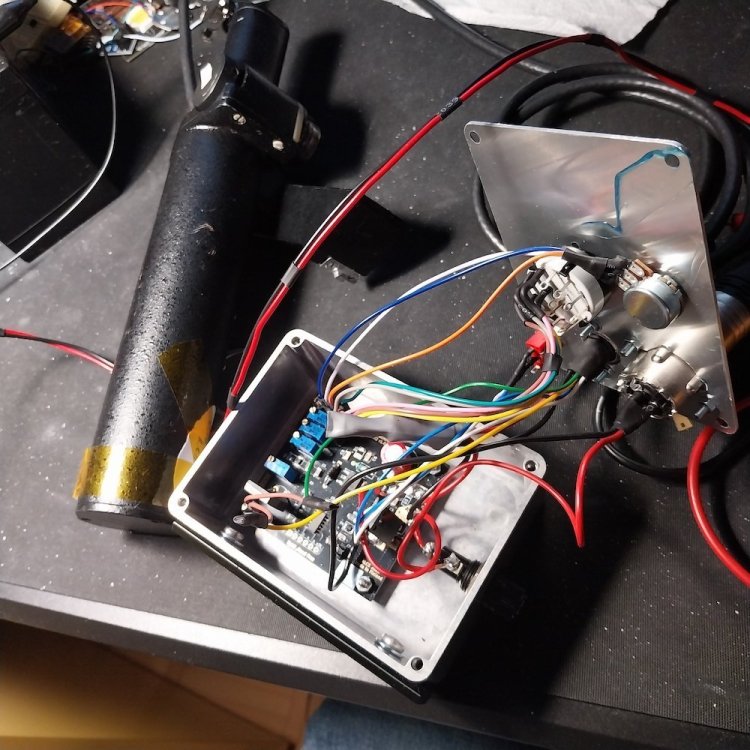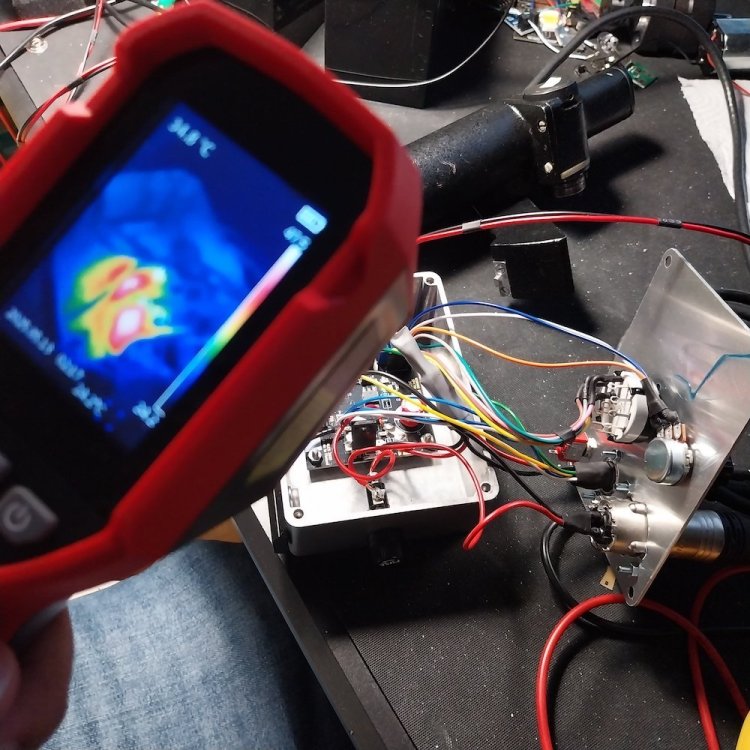-
Posts
3,336 -
Joined
-
Last visited
Everything posted by Aapo Lettinen
-

CP-GSMO new crystal sync electronics
Aapo Lettinen replied to Aapo Lettinen's topic in Cinema Products
I still have one time slot between September and November 2025 to make GSMO electronics but will need one of the gsmo bodies here in June-July to make the plans and confirm the exact features and price. I am planning on adapting my 45-speed cp16r electronics to work with the gsmo to make it more affordable and target price for the update kit would be approximately 900usd, less than a grand in any case. Will try to make it user installable but can confirm that if getting one gsmo body here for evaluation. I am probably moving on to other type of projects next year so this is likely the last chance to get new control electronics for the GSMO if you need them. The most critical now is to get one of the gsmo bodies here for evaluation and tests so that I can confirm the exact price, schedule and features and can begin planning the update. Like mentioned I only have one time slot available for this gsmo project so the schedule is pretty critical. let me know asap by DM or on instagram (aaplet14). (facebook messages don't work and disappear randomly) -
this is shot on panasonic s5 +atomos but this is what I like to do with vnsp par cans. the far background is 1k vnsp par through window and the mid ground is a 800w redhead from the doorway on the right. the foreground close to the camera is a 2k blonde through the window on the right. cold lights are small led and bounced hmi. Those small bright sunlight spots are perfect for vnsp if having them around and extra electricity available to power them and very warm sunlight is ok for the look, I nowadays just like to use the tungstens ungelled to get all the punch out of them and just gel the other lights if needed and block the real sunlight which is wildly different colour (though sometimes it just does not matter and I let the real sunlight mix for extra effect). I usually carry from 2 to 4 of those par cans and two of the 2k blondes, sometime 3 if needed
- 31 replies
-
- lighting
- natural look
-
(and 2 more)
Tagged with:
-

new ALCS compact crystal motor for Eclair NPR
Aapo Lettinen replied to Aapo Lettinen's topic in Eclair
Got the circuit boards back for the first version of the IO board. this board protects the inputs/outputs of the 6-pin accessory connector from ESD and misconnections so that the main board electronics won't get damaged if there is static electricity etc on the external connector. the same board will be used on my CP16R 45-speed camera controllers so that I have more resources to develop and test this module 🙂 will assemble a test board next week and then test with high voltage sources etc to see how well it works. 4-layer circuit board, will assemble a batch of 20 or 30 when having done all the tests and determined if this is the final version or if changes are needed. -

ALCS cp16r 45-speed crystal electronics
Aapo Lettinen replied to Aapo Lettinen's topic in Cinema Products
Got the circuit boards back for the first version of the IO board. this board protects the inputs/outputs of the 6-pin accessory connector from ESD and misconnections so that the main board electronics won't get damaged if there is static electricity etc on the external connector. the same board will be used on my NPR camera motors so that I have more resources to develop and test this module 🙂 will assemble a test board next week and then test with high voltage sources etc to see how well it works. 4-layer circuit board, will assemble a batch of 20 or 30 when having done all the tests and determined if this is the final version or if changes are needed. -

How to shoot extreme close ups
Aapo Lettinen replied to kris limbach's topic in Lenses & Lens Accessories
yes some old 2014 music video stuff. this is the 35mm ai-s nikkor with extension tubes, I think it was on 5d3 though we mostly shot on gh4. if you want this type of shots the tubes are the way to go. wider can usually be done with almost any macro lens just fine -

How to shoot extreme close ups
Aapo Lettinen replied to kris limbach's topic in Lenses & Lens Accessories
yes if the ecu is meant to be pretty much the single eye and nothing else then it can be good candidate for extension tubes. stacking tons of diopters will ruin the edges though can be used for effect if it fits the story and mood. I used to carry a 35mm ai-s nikkor with couple of extension tubes mounted to it to grab quick eye ecus for music videos. sometimes used diopters too but usually I just approximated whether I could do the shot using 2x or 4x diopter and if not then immediately switching to the 35mm + extension tubes kit. it helps with these things if you have a camera with stills mount like Nikon F, ef-mount, L-mount, M4/3, e-mount, etc. so that you can use physically small macro lens or extension tube mounted lens, helps a lot with the shadows and reflections. been 15 years since I shot this scene, I think it was the 35mm+tubes combo. full frame on 5d2 in any case -

ALCS cp16r 45-speed crystal electronics
Aapo Lettinen replied to Aapo Lettinen's topic in Cinema Products
Working on the main circuit board design for the 45-speed system. This is a draft which will change, I have not tested the exact component placement with the camera mechanics yet and need to make sure nothing is too close to the belts etc. (There is more components on the backside of the board and this is a 4-layer circuit board with quite a lot of connections on the internal layers so not possible to copy anything from the images, thus can post some work-in-progress screenshots 😄 ) Like mentioned before, the "normal" version of this control system will only be available as a preordered item. I will try to make couple of extra kits for later sale which are all with the tcxo module. Preorder prices: 750usd with shipping with normal crystal. 850usd with shipping with the tcxo module. Later sales: only tcxo module version available, price either 900 or 950usd with shipping depending on the world politics. Hopefully something like 5 kits will be available later and I may not make more of these after that so if anyone here needs the 45-speed update for cp16 camera, please preorder rather that waiting for too long. -
that is why it is so important to start to tell stories which really really matter. The days of the mindless shoestring "Michael Bay" style action flicks are over. 100 million other people would do that kind of stuff with AI in a heartbeat and no one would care to even watch them. These are the last days of real cinema. The one with real actors, with real music, real stories, resonating with the viewer deeply. Let these last days be bright and loud, full of color. Everything will eventually fade into darkness but we can keep up the real cinema as long as we care to try, as long as we don't give up. If anyone has any "too bold, too brave" scripts they thought could never be made, now is the exact time. Not next month, not next year, NOW. Humanity has never needed real art more than at this moment when the tech companies try to reduce the whole human culture to mindless "content" generated by software. I have already planned another career but will make camera motors as long as there is enough orders. will want to support film originated real art until most of the usable cameras are repaired and I will know people can manage just fine with them. Probably about 2 years or so? then will move on, probably to something aerospace related
-
pretty much all the "content-creating" positions are in danger either already now or in the following 1 to 2 years. The whole idea of the generative AI is that there is only the investors and the producer hired and everyone else is kicked out so that they don't need to pay wages at all and can keep all the profits. that is the whole purpose they created the whole technology and why they are constantly improving it. It is the absolute max of the ultra-capitalist greed... people kicked out in billions and the capitalists still think there would be the same amount of money flowing in for the companies (who the heck is buying their AI generated products if the real people don't have jobs at all? where that freakin money would be coming from huh?) so everything which does not have "deep human soul" in it will be AI generated in the very near future or already is: the tiktok and youtube content and social media postings whether having video or not. pop music and other commercial music, voiceovers, ads, most of entertainment in general. The thing which would probably be left would be very small, deeply connecting "art-house" type movies and other content. The old-school people who still remember what it was to listen to real music, watch real movies, read real books, enjoy real artworks... those are the ones asking for someone real human to make something they can connect with. They know what real art is, the art which resonates with the soul. Most of other people, the ones who consume the AI generated garbage for it being "just fine" for them, turn slowly to mindless bored "lizard-people". They consume more of the AI slop, the nicer and cooler looking stuff, it still does not connect, they don't know what is wrong... slowly their mind turns so numb that nothing can make their heart beating again. they are slaves, the slaves of the machine they can't see anymore, the one which feeds them the endless stream of mindless goo which none of matters at all
-

ALCS konvas 15epss stabilized speed controller
Aapo Lettinen replied to Aapo Lettinen's topic in Russian Gear
I sold that remaining device now. Can make another batch later this year if someone needs these, let me know by dm or on ig if wanting to order and we'll figure out the schedule then -
I found the extra finder I had in storage. It is the basic model but works and the optics are pretty good still
-

ALCS konvas 15epss stabilized speed controller
Aapo Lettinen replied to Aapo Lettinen's topic in Russian Gear
I will upload tutorial videos and other material of the device on this playlist: https://www.youtube.com/playlist?list=PLXvIUtmF3Oxt6G5MuiBc-g4n1iZSAj9gA -

ALCS cp16r 45-speed crystal electronics
Aapo Lettinen replied to Aapo Lettinen's topic in Cinema Products
Designing the IO-module for the 45-speed system. I was able to make this small enough that it can be shared with my NPR camera motors to make these in larger batches to reduce costs and improve quality. The CP16R main circuit board is relatively large and I am intentionally using larger sized components on the main board for mechanical strength. Using tiny parts is reliable if having them on separate circuit board like this, I am using from 3x to 4x smaller components on this module than on the main circuit board so that I can stack more features in the same board area. This IO module contains optocouplers and other parts isolating the 6-pin accessory connector from the sensitive microcontrollers on the main circuit board. If there is large electrostatic discarge, misconnection etc. on the 6-pin connector they will likely just destory components on this IO module and one can swap the module to new one instead of desoldering and swapping similar-functioning components on the main board. board dimensions about 48mm x 28mm and the smallest components are 1.6mm in length. I am assembling these by reflow soldering and only manually soldering the connectors in place. -

new ALCS compact crystal motor for Eclair NPR
Aapo Lettinen replied to Aapo Lettinen's topic in Eclair
I decided to make the IO module in two parts. The difficult-to-repair small components are on this separate small circuit board which can be detached easily and switched to new one if needed, no need to solder any wires. This mounts to the other circuit board underneath which has big capacitors and other larger parts and soldered wires. Making this board separate allows me using 3x smaller parts which makes it possible to assemble these more easily by reflow soldering and it also allows sharing this same module with the CP16R 45-speed system so that I can save costs and improve quality when being able to make these modules in larger batches, from 15 to 20 at a time instead of 5 at a time which would have been possible with the all-integrated single circuit board. The smallest components used on the module are 1.6mm long. 4-layer circuit board, lenght a bit over 47mm and width a little over 28mm at the moment. -

ALCS konvas 15epss stabilized speed controller
Aapo Lettinen replied to Aapo Lettinen's topic in Russian Gear
The remaining device from the first batch is reserved for couple of weeks, probably sold but need to wait. If someone has very urgent need ("must have this device!") to have this type of speed controller, I might sell my prototype device which has a scratch or two. I can make another batch of these controllers somewhere between July and December 2025 depending on when there is enough orders in to make it possible. The manufacturer of the 6-pin connector managed to discontinue them just when I was ordering more of them so I need to change the connector type on the next batch, thus will probably need to change the front panel too to have different mounting for the other type of connector. this will create additional expenses. So I will need to collect two or three orders and can make more of these. There is a deposit of 100usd when placing the order and when I have 2 or 3 orders or more I will charge the rest of the purchase price and make the batch. Let me know by DM or on Instagram (aaplet14) if wanting to order these. -
yes absolutely it is needed to have a day job to be able to do cinematography stuff nowadays. But that also makes it possible to choose which projects you want to do instead of needing to hoard any kind of stuff which pays a penny just to have something to work on. You will make less projects but they will probably be much better quality so you'll potentially get forward at same pace or faster even. Nowadays when most of the entertainment stuff is mindless "content" and ever growing amount of it is AI generated, you really need to concentrate on meaningful important stories with deep human soul. You really can't compete with the "Oh Look It's a Cool Explosion" stuff anymore as a low budget indie filmmaker, that is the job of the "influencer" content creators using AI and sponsor money. Just look for deeply human very touching stories around you and make small films out of those. That kind of material is perfect to be shot on real film too. If you have more money then shoot more, if having less then shoot a bit less of projects but keep the quality high
-
additionally, leds DO age and after couple of years of use you will probably need to buy new ones because the current ones are too green and dim then. So don't expect using the same lights 5 years from now. Upgrading your whole kit often is very expensive but if you have relatively cheap led lights now when starting it is not a big deal to upgrade later on and they save tons of time compared to old technology. Tungsten and hmi fixtures do not age, you just change the bulb after some 1000+ hours of use and you are good as new again. with led you need to buy a new light when the "bulb" ages and it may not be after more than couple of thousand hours. So leds save time but they are expensive to use. Tungsten and hmi are slow to use but they often save money if used right because they may be much cheaper to buy and will definitely be cheaper to use (if the electricity assumed being free). I think one would have lots of use for both technologies even in today's world where people are fanatic about led being the only sensible technology. One more thing, on this low budget level, choose your lighting gear so that you can fit all of it in your car and there can still be one passenger fitted in and you can fit the camera gear in too. If you have stuff which you can't fit in the car you will never use it and no sense to keep extra ones as backup at home, you won't get them from there anyway if something blows up on set 🙂 So take stands, frames etc which can fit in your own car and with the stands, lights, flags, sandbags etc. all in the car there is still one passenger seat left and no more than 2/3 of the space used by the lights so that you can still fit the camera, tripod and grip gear etc in with your extra clothing, snacks, etc.
-
and get a basic lighting kit so that you can experiment a lot and use that on the small shoots instead of using money on renting. couple of cob led lights with accessories like softbox, possible fresnel lens etc and at least some of them battery powered, some battery powered tube lights, a mat light or two, stands and frames and flags and sandbags etc. Check out every used lighting gear source regularly to pick up used stands and other support stuff, they are usually totally fine even when roughly handled for years. You can experiment with old used tungsten lights if you get them for very cheap, for example fresnels up to 2kw and the 2kw blonde lights are great if you have time to arrange power for them. Nowadays I use to use tungsten lights as "semi-fixed" like hmi lights, they are not moved from shot to shot but may be tuned a little if absolutely needed and may still move from scene to scene. Then every light which is moved shot to shot is led, with the most often moved small powered lights on battery power so that you don't need to mess up with cables and save tons of time. On leds you will want some kind of remote control possibility because they are the ones tweaked all the time. with the possible tungsten lights you just need high-ish powered ones and lots of them so that you can add extra light to the background whenever needed to make a "much bigger looking lighting kit than it actually is". For example I used two 2kw blondes side by side to make sunlight, then opposite direction far background windows were lit with 1k vnsp cans, and the middle ground open door sunlight coming in was another tungsten too. Then I had led mat and some smaller leds as fill and lighting the foreground actor and some bounced hmi or led for ambience. Only the leds were bought new, the other lights were mostly from the 80's and 90's and got them for very cheap so instead of spending thousands on multiple high powered cob leds I could do most of the set with very cheap tungsten and only used led on fixtures which needed to move all the time from shot to shot.
-
I would do short projects on the side and save money for bigger ones which you can do later when having gained very good skills and confidence doing the small scale stuff. Music videos can be good for testing stuff and quick learning, just make sure someone else pays the costs and you would get something small as a compensation so that you can save for short film projects. You can test all kinds of visual storytelling and beauty shots, crazy lighting ideas and operating, etc. on music videos. They don't usually pay well or at all but they are good as testing platform for stuff which can be used for getting small commercial shoots etc later on. You will want to upgrade the camera at some point, depends on how much you are able to work and advance but I would guess from 1 to 2 years maybe. If possible, keep the Bolex as a backup and for taking quick mos pickups. If the Bolex is not S16 converted, I would probably leave it as N16 shooting lower grain film to compensate for the grain difference, and invest on higher level camera when having possibility. Something entry level which is relatively silens, sync sound capable and can use larger rolls, for example Eclair NPR with good crystal motor, and get that S16 converted then.
-

K3 Needs CLA - Looking For European Technician
Aapo Lettinen replied to Willem Jansen's topic in Russian Gear
Can you post a video with good sound, running the camera for the full lenght of the spring? It might be possible to guess from the sound what might be wrong with it -

K3 Needs CLA - Looking For European Technician
Aapo Lettinen replied to Willem Jansen's topic in Russian Gear
Shipping and payment to Russia would be a nightmare to arrange and takes very long so would not bother unless you want both s16 mod and pl mount mod at the same time. Shipments go via middlemen in 3rd countries like UAE and Kazakhstan and payment similar way to cheat the sanctions. Some of my friends have shipped k3 back and forth and I think it takes typically approx 3 weeks to 1 month to get it to Russia and from 1 to 3 months for return shipping. That is just the shipping time. The cla and mod work time on top of that. I don't think it is worth it to smuggle these cheap camera bodies to Russia and back for great effort just to get a simple cla done -

ALCS konvas 15epss stabilized speed controller
Aapo Lettinen replied to Aapo Lettinen's topic in Russian Gear
First finished device sent to a client today. Will assemble two more soon and make some tutorial videos of it. The preliminary stability tests looked like it could be used for short sync sound takes easily if calibrated correctly. Temperature changes the calibration so one needs to let the device warm up properly before trying calibration. I think one could try shoot 1min to 2min sound takes with this device without much issues. The speed stability is really good, it is just about whether the selected speed preset is a little offset a little up or down if the calibration was done hastily at different temperature than the device is normally running at. The variable speed knob is sync too so it keeps the selected framerate constant during mechanical load changes on the camera. If hastily needing some speed preset which is not internally calibrated to the A/B/C presets, one could just use the variable speed knob to dial in some custom framerate quickly and check from the camera body 's tachometer if the speed is close enough to the desired one. It is not good for the internal wires to constantly open the device for changing the speed presets all the time, I estimated something like 3 times a year should still be fine so that the wires will last long. Of course you can do it more often if prepared to resolder some wires back to the circuit board if they snap after bazillion opening of the front panel 😄 ------------------------------ There is one extra controller available for order, takes a week or two to prepare for shipping if ordered now. I don't know when I will have next chance to assemble more of these but probably late Autumn I think. If there is more orders I will make another batch when having possibility . It is possible to diy modify the 15epss motor handle to work with this controller. Different handles have slightly different tachometer generators so the device is calibrated for the specific motor at a time and if using multiple motor handles with this you will need to recalibrate after changing the handle, or accept that the speed presets are a little off like 0.3 or 0.4fps off if the controller is not user calibrated with that particular handle -

How to shoot extreme close ups
Aapo Lettinen replied to kris limbach's topic in Lenses & Lens Accessories
sometimes with specific macro but usually a 1x or 2x or 4x diopter which can be thrown on quickly so that it does not slow down the other shooting too much. If you need shots like one eye filling the whole screen or closer then a macro lens is better than trying to stack diopters to get anywhere near the same magnification. But if it is just "normal ECU" then take a lens which focuses close and throw some diopter on it -

ALCS konvas 15epss stabilized speed controller
Aapo Lettinen replied to Aapo Lettinen's topic in Russian Gear
Thermal stress testing. I am testing the heat generating parts with thermal camera at maximum load to ensure that they are not overheating in use. Decided to mount the power FET differently but otherwise works fine. Small software tuning and remounting the FET with more passive cooling, then it is finished. -

Anyone need a Crystal Sync motor for Kinor 16CX cameras?
Aapo Lettinen replied to Aapo Lettinen's topic in Russian Gear
It could be a pretty good deal to buy my Kinor kit with the 10-speed motor if you don't have the camera yet and want to use that motor type with that camera model. The motor alone costs about 1k and I was thinking of selling the whole kit for 2k with the motor included. I have a partial spare parts camera and other stuff which can maybe be included too, the idea of selling the camera body was just to get rid of extra cameras I don't normally have time to use for my own projects and to get some extra movie projects shot when testing the cameras preparing them for shipping. and selling one extra motor. selling the camera body itself does not create any revenue, I am just including a new motor with it to get money from the motor sale 😄



